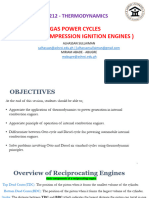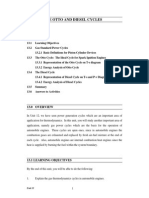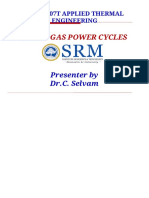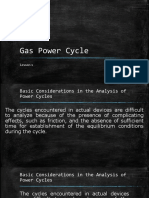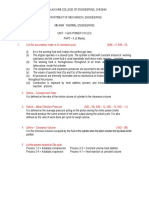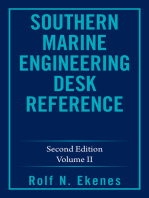Two Marks IVth Unit
Two Marks IVth Unit
Uploaded by
aadhanCopyright:
Available Formats
Two Marks IVth Unit
Two Marks IVth Unit
Uploaded by
aadhanCopyright
Available Formats
Share this document
Did you find this document useful?
Is this content inappropriate?
Copyright:
Available Formats
Two Marks IVth Unit
Two Marks IVth Unit
Uploaded by
aadhanCopyright:
Available Formats
BHARATHIYAR COLLEGE OF ENGINEERING AND TECHNOLOGY
KARAIKAL
B.Tech ODD SEM Question Bank
T 105 THERMODYNAMICS
(Common to all branches)
TWO MARKS QUESTION AND ANSWER
UNIT- IV GAS POWER CYCLES
1. Define: Thermodynamic cycles.
Thermodynamic cycle is defined as the series of processes performed on the system, so that the
system attains to its original state.
2. Classification of thermodynamics cycles
Thermodynamics cycles can be classified into different categories depending on fluid used or the
different processes:
Gas and vapor cycles
1- Gas cycle: the working fluid remains in gaseous phase throughout the entire cycle.
2- Vapor cycle: the working fluid exists in the vapor phase during one part of the cycle
and in the liquid phase during another part.
Open and closed cycles
1- Open cycle: the working fluid is returned to the initial state at the end of the cycle and
is re circulated.
2- Closed cycle: the working fluid is renewed at the end of each cycle instead of re
circulated.
3. How to increase the efficiency of a cycle?
a) By increasing the net work.
b) By decreasing the amount of heat rejection.
c) By increasing the mean temperature of heat addition or by decreasing the mean
temperature of heat rejection.
4. Define the term compression ratio.
Compression ratio is the ratio between total cylinder volumes to clearance volume. It is denoted
by the letter r
5. Write the expression for efficiency of the Otto cycle?
1
Efficiency
otto
= 1 - ---------
(r)
-1
6. What is meant by cut-off ratio?
Cut-off ratio is defined as the ratio of volume after the heat addition to before the heat addition. It
is denoted by the letter
7. What are the assumptions made for an air standard Cycle?
Air is the working substance.
Throughout the cycle, air behaves as a perfect gas and obeys all the gas laws.
No chemical reaction takes place in the cylinder
Both expansion and compression are strictly isentropic
The values of specific heats of the air remain constant throughout the cycle.
8. What is the difference between Otto and Diesel Cycle.
Otto Cycle Diesel Cycle
1. Otto cycle consist of two adiabatic and
two constant volume process.
1. It consists of two adiabatic, one constant
volume and one constant pressure
processes.
2. Compression ratio is equal to expansion
ratio
2. Compression ratio is greater than
expansion ratio.
3. Heat addition takes place at constant
volume.
3. Heat addition takes place at constant
pressure
4. Compression ratio is less. It is varies
from 6 to 8.
4. Compression ratio is more. It varies
from 12 to 18.
9. What is meant by air standard efficiency of the cycle?
It is defined as the ratio of work done by the cycle to the heat supplied to the cycle.
Work done
Efficiency = --------------
Heat supplied
10. Define: Mean effective pressure of an I.C. engine.
Mean effective pressure is defined as the constant pressure acting on the piston during the
working stroke. It is also defined as the ratio of work done to the stroke volume or piston
displacement volume. It is denoted by P
m.
11. Define: Specific fuel consumption.
SFC is defined as the amount of fuel consumed per brake power hour of work.
12. What is meant by calorific value of a fuel?
Calorific value of a fuel is defined as the amount of heat liberated by the compete combustion of
unit quantity of a fuel.
13. Give the expression for efficiency of the Dual cycle.
1 k
- 1
Efficiency = 1 - ------- X -----------------
(r)
-1
(k-1) + k (-1)
where,
r Compression ratio
k Pressure or Expansion ratio
Cut off ratio and
Adiabatic index
14. What are the factors influencing of the Dual cycle?
1. Compression ratio 2.cut off ratio 3. Pressure ratio and 4. Heat supplied at constant volume
and constant pressure.
15. Give the expression for efficiency of the Brayton cycle.
1
Efficiency = 1 - ---------- where K Pressure ratio.
(K)
-
/
16. What is the fuel injector?
Fuel injector is used in diesel engine to inject and atomize the diesel at the end of the
compression stroke.
17. What is meant by SI engine? Why it is called so?
SI engine means spark ignition engine. In SI engine air fuel mixture is ignited by spark plug hence
it is called spark ignition engine. It is also called as petrol engine.
18. What is meant by CI Engine? Why it is called so?
CI engine means compression ignition engine. In CI engine the fuel is injected by a fuel injector in
atomized form because of high compressed air it gets ignited automatically. Hence it is called as
compression ignition engine.
19. What is a two stroke engine?
A two stroke engine is an engine in which one cycle of operation is completed in two stroke of the
piston or one revolution of the crank shaft.
20. What is a four stroke engine?
A four stroke engine is an engine in which one cycle of operation is completed in four stroke of
the piston or two revolution of the crank shaft.
21. Name the four strokes of an IC engine?
Suction, Compression, Power and Exhaust stroke.
22. Differentiate petrol and Diesel engines.
Petrol or SI engines Diesel or CI engine
1. Combustion of air fuel mixture takes
place by spark produced by sparkplug.
1. Combustion takes place by high
compressed air.
2. Carburetor is used to mix the air fuel
mixture.
2. Fuel injector is used to inject the fuel in
atomized form.
3. Compression ratio varies from 6 to 8. 3. Compression ratio varies from 12 to 18.
4.It works on Otto cycle. 4. It works on Diesel or Dual cycle.
23. What is compression ratio?
Compression ratio is defined as the ratio between total cylinder volume and clearance volume.
Total volume V
c
+V
s
Compression ratio = ------------------- -----------
Clearance Volume V
c
24. What are the processes involved in Otto cycle?
Otto cycle consists of four processes, namely, adiabatic compression, constant volume heat
addition, adiabatic expansion and constant volume heat rejection.
25. What are the processes involved in Diesel cycle?
Diesel cycle consists of four operations, namely, adiabatic compression, constant pressure heat
addition, adiabatic expansion and constant volume heat rejection.
26. What are the processes involved in Duel cycle?
Duel cycle consists of five operations, namely, adiabatic compression, constant volume heat
addition, constant pressure heat addition, adiabatic expansion and constant volume heat rejection.
27. Compare Otto, Diesel and Duel cycles with respect to their performance?
Otto cycle has the highest work output and efficiency. Diesel cycle has the lowest and Duel cycle
has the efficiency between two
28. Define Top Dead Center and Bottom Dead Center?
The top most position of the piston inside the cylinder. i.e. when it is at the maximum distance
from the crankshaft axle is known as Top Dead Center (TDC).
The bottom most position of the piston inside the cylinder is called Bottom Dead Center (BDC)
29. Define Bore and Stroke of an Engine?
The diameter of the cylinder is called Bore. The distance between TDC and BDC is known as
stroke or piston travel.
30. Define Clearance volume, Swept or Stroke volume, and Cylinder volume?
The space above the piston, when the piston is at TDC is called Clearance volume
The volume swept through by the piston, as it moves from one dead center to the other is
called swept volume or stroke volume.
The volume above the piston, when the piston is at BDC is called cylinder volume. The
cylinder volume is the sum of the clearance volume and stroke volume
31. What is meant by the Cubic Capacity of an engine?
The cubic capacity of engine or engine displacement or engine size is the product of the stroke
volume in one cylinder and the number of the cylinders in the engine.
32. Sketch P-V and T-S diagram for Otto cycle?
Process 1-2: Reversible adiabatic compression of air.
Process 2-3: Heat addition at constant volume.
Process 3-4: Reversible adiabatic expansion of air.
Process 4-1: Heat rejection at constant volume.
33. Sketch P-V and T-S diagram for Diesel cycle?
34. Sketch P-V and T-S diagram for Brayton or Joule cycle?
Additional Questions
1. State Clausius inequality?
Clausius inequality states that when the system undergoes a cyclic process, the summation of
dQ/T around a closed cycles is less than or equal to ZERO
(dQ/T)
rev
0 This equation is called inequality
If (dQ/T)
rev
= 0 cycle is reversible,
(dQ/T)
rev
< 0 cycle is irreversible,
(dQ/T)
rev
> 0 cycle is impossible
2. State the types of irreversible process?
An irreversible process is one in which heat is transferred through a finite temperature.
Irreversibilitys are of two types
External irreversibilitys: these are associated with dissipating effects outside the
working fluid
Internal irreversibilitys: These are associated with dissipating effects within the working
fluid
3. Mention the various processes of the Brayton cycle?
Isentropic compression
Constant pressure heat supplied
Isentropic expansion
Constant pressure heat rejection
4. Conversion factors
Pressure 1 Bar = 10
5
N/m
2
1 pa = 1 N/m
2
1 atm = 760 mm of Hg ,
1.01325 bar
1 joule = 1 n-m , 1 watt-sec
1 watt = 1 joule/sec
1 KW = 1000 watts
Ratio of specific heats = 1.4 ( for air)
Sp.Heat at constant pressure C
p
= 1.005 KJ/Kg K
Sp.Heat at constant volume C
v
= 0.718 KJ/Kg K
Gas constant R = 0.287 KJ/Kg K
Universal gas constant M= 8.314 KJ/Kg.mol K
= C
p
/C
v
R = C
p
-C
v
C
v
/C
p
= 1/
C
v
= R/-1
$$$$$$$$$$$$$$$
You might also like
- Q and A For 2 Marks New Thermal EngineeringDocument43 pagesQ and A For 2 Marks New Thermal EngineeringPaul Arokiam S0% (1)
- Te QbwaDocument50 pagesTe Qbwasrinithims78No ratings yet
- Unit I Gas Power CyclesDocument56 pagesUnit I Gas Power CyclesUdayasankar UdaysNo ratings yet
- Thermal Engineering Unit I For BE StudentsDocument44 pagesThermal Engineering Unit I For BE Studentsba27100% (8)
- ThermonotesDocument7 pagesThermonotesjohnNo ratings yet
- Thermal 2 MarksDocument14 pagesThermal 2 MarksDhanush RajNo ratings yet
- Me 2301 - Thermal EngineeringDocument10 pagesMe 2301 - Thermal EngineeringsrajapratyNo ratings yet
- Unit I - Gas Power Cycles: Department of Mechanical EngineeringDocument15 pagesUnit I - Gas Power Cycles: Department of Mechanical EngineeringpvrbalaNo ratings yet
- 8 ME212 Gaspowercycles (SI CIengines)Document19 pages8 ME212 Gaspowercycles (SI CIengines)mosesdayesNo ratings yet
- 2131905Document36 pages2131905inam vfNo ratings yet
- Otto and Diesel CyclesDocument16 pagesOtto and Diesel CyclesYogaisan RamasawmyNo ratings yet
- Thermal Engineering Unit I For BE Students PDFDocument44 pagesThermal Engineering Unit I For BE Students PDFsridevi73No ratings yet
- Chapter 2Document14 pagesChapter 2Abdullah OmerNo ratings yet
- Gas Cycles - Part IDocument22 pagesGas Cycles - Part ImohsinsafiNo ratings yet
- UNIT I Gas Power Cycles FinalDocument75 pagesUNIT I Gas Power Cycles FinalMAYUR BHOSALENo ratings yet
- Me8493-Thermal Engineering - I-993512870-Te QB Part A &BDocument20 pagesMe8493-Thermal Engineering - I-993512870-Te QB Part A &BMarites TuyogonNo ratings yet
- Applied Thermodynamics and Heat Transfer NotesDocument56 pagesApplied Thermodynamics and Heat Transfer NotesS A ABDUL SUKKURNo ratings yet
- ME4 Thermal EngineeringDocument22 pagesME4 Thermal EngineeringEric CookNo ratings yet
- Lecture On: Dr. Nitesh MondalDocument10 pagesLecture On: Dr. Nitesh MondalNitesh MondalNo ratings yet
- L 1 Gas Power Cycle 1Document77 pagesL 1 Gas Power Cycle 1De Jose Niño VonNo ratings yet
- Srinivasan Engineering College, Perambalur-621212: Question Bank Unit I Gas Power CyclesDocument18 pagesSrinivasan Engineering College, Perambalur-621212: Question Bank Unit I Gas Power CyclesagrikarthiNo ratings yet
- Gas Power CyclesDocument7 pagesGas Power CyclesLegenGaryNo ratings yet
- Module 3 - Ideal Models of Engine CyclesDocument37 pagesModule 3 - Ideal Models of Engine CyclesMuhammad BilalNo ratings yet
- Unit 1Document16 pagesUnit 1diksha singhNo ratings yet
- 22Document57 pages22Vvavv VengatNo ratings yet
- Kuliah - 02 Teknik KendaraanDocument61 pagesKuliah - 02 Teknik Kendaraananthony martialNo ratings yet
- Mechanical Engineering Thermodynamics II - Lecture 03 - 27 SepDocument25 pagesMechanical Engineering Thermodynamics II - Lecture 03 - 27 SepThineshraaj Naidu Jaya RamanNo ratings yet
- CHAP 3 Gas - Power CyclesDocument88 pagesCHAP 3 Gas - Power CyclesMuez GhideyNo ratings yet
- Thermal Engineering Question BankDocument33 pagesThermal Engineering Question BankmechgokulNo ratings yet
- Air Standed Cycles Lec-7Document20 pagesAir Standed Cycles Lec-7pleasename1No ratings yet
- BE8256-Basic Mechanical Engineering Chemical Engineering 2018-2019Document5 pagesBE8256-Basic Mechanical Engineering Chemical Engineering 2018-2019dsathiyaNo ratings yet
- Cranfield University: Piston Engines Module Lecture NotesDocument242 pagesCranfield University: Piston Engines Module Lecture NotesIzzadAfif1990No ratings yet
- Gas Power Cycles: Chapter FiveDocument46 pagesGas Power Cycles: Chapter FivenunuNo ratings yet
- 3-Torque and Power Output and Engine EfficiencyDocument18 pages3-Torque and Power Output and Engine EfficiencyAHMADNo ratings yet
- Analysis of Gas Power CyclesDocument8 pagesAnalysis of Gas Power CyclesPradeep SandhalNo ratings yet
- Thermal Engineering-Question BankDocument32 pagesThermal Engineering-Question BankAlfred Franklin VNo ratings yet
- Me6404 Te Even QBDocument32 pagesMe6404 Te Even QBBala NarayanasamyNo ratings yet
- Chapter5internalcombustionengine 150613191033 Lva1 App6891Document53 pagesChapter5internalcombustionengine 150613191033 Lva1 App6891MatnSambuNo ratings yet
- CHAPTER 5 Internal Combustion EngineDocument49 pagesCHAPTER 5 Internal Combustion EngineYann YeuNo ratings yet
- Teoria y Problemas PulkrabeckDocument53 pagesTeoria y Problemas Pulkrabeckpaula daniela rincón garcíaNo ratings yet
- Engine Theory and CalculationsDocument11 pagesEngine Theory and Calculationsmuhammad husnain100% (1)
- Thermal Engg Qbank 2017 FinalDocument10 pagesThermal Engg Qbank 2017 FinalBalaji DsNo ratings yet
- Lec9 PDFDocument34 pagesLec9 PDFshravanNo ratings yet
- Heat Engine Question-1Document31 pagesHeat Engine Question-1Mohammed youssifNo ratings yet
- Question Bank 20.11.2017Document32 pagesQuestion Bank 20.11.2017tagoreboopathy0% (1)
- ATD Unit 3.1Document18 pagesATD Unit 3.1Mr. P. Ramkumar MECHNo ratings yet
- MEng3102 Chapter 2Document31 pagesMEng3102 Chapter 2Hinsermu NeftalemNo ratings yet
- A. Otto Cycle (Gasoline Engine)Document22 pagesA. Otto Cycle (Gasoline Engine)John Manuel BautistaNo ratings yet
- ME8493 Important Questions PDFDocument6 pagesME8493 Important Questions PDFNihal AshikNo ratings yet
- BMM2523_Chapter 2 thermodynamics9-13 An air-standard cycle executed in a piston-cylinder system is composed of three specified processes. The cycle is to besketcehed on the P - v and T - s diagrams and the back work ratio are to be determined. Assumptions 1 The air-standard assumptions are applicable. 2 Kinetic and potential energy changes are negligible. 3 Air isan ideal gas with constant specific heats. Properties The properties of air are given as R = 0.287 kPa·m 3 /kg·K, c p = 1.005 kJ/kg·K, c v = 0.718 kJ/kg·K, and k =1.4. Analysis (a) The P - v and T - s diagrams of the cycle are shown in the figures.(b) Process 1-2: Isentropic compression )( 12,21 T T mcw in −= − v s T 321 v P 321 11212 =⎟⎟ ⎠⎜⎜⎝ = r T T T v 11 −− ⎞⎛ k k v rocess 2-3: Constant pressure heat addition T T mRP −=−= V V v he back wrk ratio isP 2,32 Pd w out = ∫ − )()( 232323 To )()( 2312,32,21 T T mRT TDocument11 pagesBMM2523_Chapter 2 thermodynamics9-13 An air-standard cycle executed in a piston-cylinder system is composed of three specified processes. The cycle is to besketcehed on the P - v and T - s diagrams and the back work ratio are to be determined. Assumptions 1 The air-standard assumptions are applicable. 2 Kinetic and potential energy changes are negligible. 3 Air isan ideal gas with constant specific heats. Properties The properties of air are given as R = 0.287 kPa·m 3 /kg·K, c p = 1.005 kJ/kg·K, c v = 0.718 kJ/kg·K, and k =1.4. Analysis (a) The P - v and T - s diagrams of the cycle are shown in the figures.(b) Process 1-2: Isentropic compression )( 12,21 T T mcw in −= − v s T 321 v P 321 11212 =⎟⎟ ⎠⎜⎜⎝ = r T T T v 11 −− ⎞⎛ k k v rocess 2-3: Constant pressure heat addition T T mRP −=−= V V v he back wrk ratio isP 2,32 Pd w out = ∫ − )()( 232323 To )()( 2312,32,21 T T mRT Tmh13001No ratings yet
- Chapter TwoDocument80 pagesChapter TwobroNo ratings yet
- Chapter 3 Summary - Andrew AymanDocument30 pagesChapter 3 Summary - Andrew Aymanbg41255No ratings yet
- Bcme Mech Part Unit-2Document13 pagesBcme Mech Part Unit-2dhanushadas2No ratings yet
- Otto CycleDocument7 pagesOtto CycleNitesh MondalNo ratings yet
- SME1207Document201 pagesSME1207OM TAPARENo ratings yet
- LEC# 06. Petrol, Diesel, Rankine, Brayton CyclesDocument33 pagesLEC# 06. Petrol, Diesel, Rankine, Brayton CyclesAns ahmedNo ratings yet
- Southern Marine Engineering Desk Reference: Second Edition Volume IiFrom EverandSouthern Marine Engineering Desk Reference: Second Edition Volume IiNo ratings yet
- Design of Machine ElementsDocument53 pagesDesign of Machine ElementsSrks Kondal Reddy100% (2)
- S3 VMRDocument12 pagesS3 VMRaadhanNo ratings yet
- Bharat Sanchar Nigam Limited: Receipt DetailsDocument1 pageBharat Sanchar Nigam Limited: Receipt DetailsaadhanNo ratings yet
- SpiceJet - E-Ticket - PNR J2CT7Y - 23 Nov 2015 Chennai-Delhi For MRS. KANAGARAJDocument2 pagesSpiceJet - E-Ticket - PNR J2CT7Y - 23 Nov 2015 Chennai-Delhi For MRS. KANAGARAJaadhanNo ratings yet
- Mech Syllabus PDFDocument162 pagesMech Syllabus PDFaadhanNo ratings yet
- Design of Machine ElementsDocument53 pagesDesign of Machine ElementsSrks Kondal Reddy100% (2)
- Dynamics of Machinery PDFDocument18 pagesDynamics of Machinery PDFThomas VictorNo ratings yet
- Design of Machine ElementsDocument53 pagesDesign of Machine ElementsSrks Kondal Reddy100% (2)
- Classificaitons of Fluid MachinesDocument4 pagesClassificaitons of Fluid MachinesaadhanNo ratings yet
- Dynamics of Machinery PDFDocument18 pagesDynamics of Machinery PDFThomas VictorNo ratings yet
- P-103 Engineering Graphics Lab: DATE: 26-12-2013 TIME: 09.30AM - 12.30 PMDocument3 pagesP-103 Engineering Graphics Lab: DATE: 26-12-2013 TIME: 09.30AM - 12.30 PMaadhanNo ratings yet
- B48BA Tutorial 2 Mass Balance-1Document2 pagesB48BA Tutorial 2 Mass Balance-1Mohamed AbdullaNo ratings yet
- Safety Data Sheet: Section 1: Identification of The Substance/mixture and of The Company/undertakingDocument6 pagesSafety Data Sheet: Section 1: Identification of The Substance/mixture and of The Company/undertakingajoilhamNo ratings yet
- Msds BlueDocument5 pagesMsds BlueAngga Buledhbuledh PerdanaNo ratings yet
- P 651 14 HPC 3 08 DSD DSDX SeriesDocument7 pagesP 651 14 HPC 3 08 DSD DSDX Serieseka prasetia0% (1)
- Solanum Nigrum With Dynamic Therapeutic RoleDocument7 pagesSolanum Nigrum With Dynamic Therapeutic RoleFadli SukandiarsyahNo ratings yet
- DiodeDocument19 pagesDiodekeshavkthakurNo ratings yet
- Sorbtech MiniCatDocument110 pagesSorbtech MiniCatSoma GhoshNo ratings yet
- Experiment 20 Reduction of Vanillin HANDOUTDocument9 pagesExperiment 20 Reduction of Vanillin HANDOUTTok WanNo ratings yet
- Buried Silicon-Germanium Pmosfets: Experimental Analysis in Vlsi Logic Circuits Under Aggressive Voltage ScalingDocument9 pagesBuried Silicon-Germanium Pmosfets: Experimental Analysis in Vlsi Logic Circuits Under Aggressive Voltage ScalingI.k. NeenaNo ratings yet
- DacrometDocument6 pagesDacrometdavideNo ratings yet
- External CirclipsDocument4 pagesExternal CirclipsZarko KacakovNo ratings yet
- Effects of Air Pollutants: Che Pe3 Air Pollution ControlDocument11 pagesEffects of Air Pollutants: Che Pe3 Air Pollution ControlKitty LastNo ratings yet
- Basic Concepts - Chapter 1Document14 pagesBasic Concepts - Chapter 1RezhaNo ratings yet
- Draw-Peeling Improves Wire Quality: Surface TreatmentDocument1 pageDraw-Peeling Improves Wire Quality: Surface TreatmentYahyaMoummouNo ratings yet
- Valve Material Selection ChartDocument10 pagesValve Material Selection ChartAshwanth RameshNo ratings yet
- Triaxial Test IntroductionDocument4 pagesTriaxial Test IntroductionAshadi Hamdan100% (3)
- Mechanical and Physical Properties of Astm c33 SandDocument39 pagesMechanical and Physical Properties of Astm c33 SandBatepola BacNo ratings yet
- Module 4: Worked Out ProblemsDocument10 pagesModule 4: Worked Out ProblemscaptainhassNo ratings yet
- Tijsseling 1996Document38 pagesTijsseling 1996mohammad alajarmeh100% (1)
- Coal Mine Ventilation Systems in The United States of AmericaDocument8 pagesCoal Mine Ventilation Systems in The United States of AmericaYvan BravoNo ratings yet
- Povidone Iodine USPDocument2 pagesPovidone Iodine USPJansen B. LaurenNo ratings yet
- Ultracel 3000 - en - 06476619 13015246 13775256Document2 pagesUltracel 3000 - en - 06476619 13015246 13775256s0n1907No ratings yet
- Ge DP MC FinalDocument7 pagesGe DP MC FinalinstsureshNo ratings yet
- Nepal Environmental & Scientific Services (NESS) Pvt. Ltd. GPO Box No: 7301 Jitjung Marga 26, Thapathali Kathmandu, NepalDocument35 pagesNepal Environmental & Scientific Services (NESS) Pvt. Ltd. GPO Box No: 7301 Jitjung Marga 26, Thapathali Kathmandu, NepalAnonymous lVbhvJfNo ratings yet
- Modification of Normalised Difference Water Index (NDWI) To Enhance Open Water Features in Remotely Sensed Imagery (NDWI)Document10 pagesModification of Normalised Difference Water Index (NDWI) To Enhance Open Water Features in Remotely Sensed Imagery (NDWI)sergonzalezNo ratings yet
- Heat EnergyDocument18 pagesHeat EnergyPiyumi Gallage100% (2)
- Exp1 The Solubility of A SaltDocument8 pagesExp1 The Solubility of A Saltsomon pierre GAHIMBARENo ratings yet
- Chapter 6Document43 pagesChapter 6Pirate CaribbeanNo ratings yet
- Dyeing, Printing and FinshingDocument23 pagesDyeing, Printing and FinshingMuhammad SagheerNo ratings yet
- Bonding Exam Style Questions (Chemistry)Document30 pagesBonding Exam Style Questions (Chemistry)Temilola OwolabiNo ratings yet








